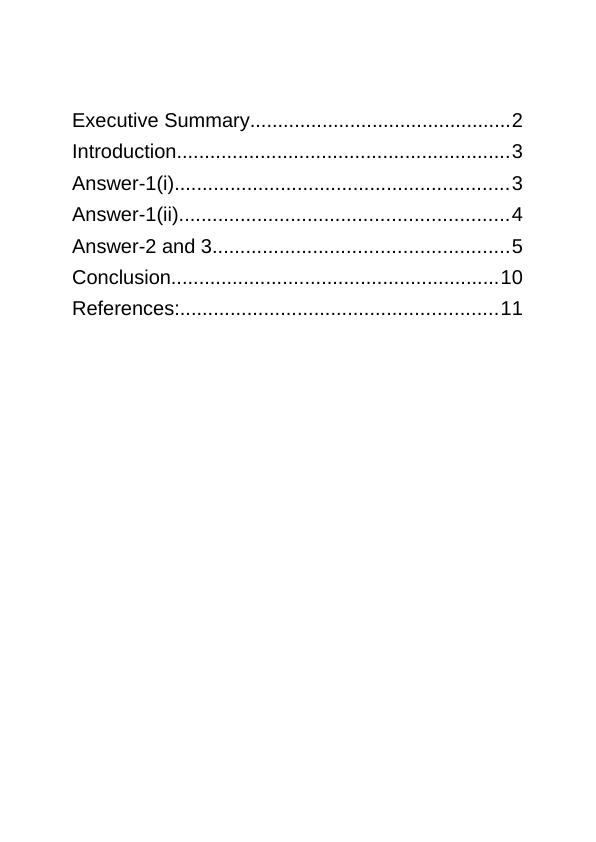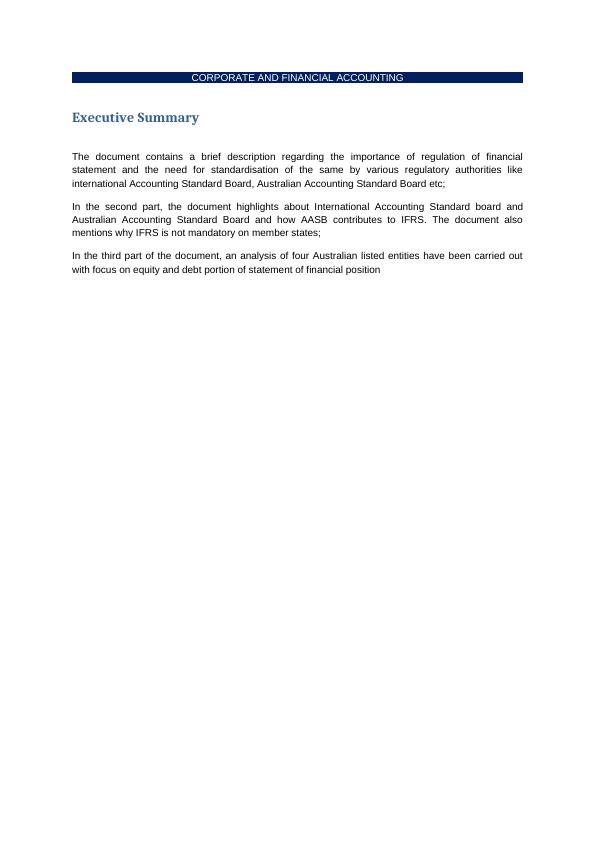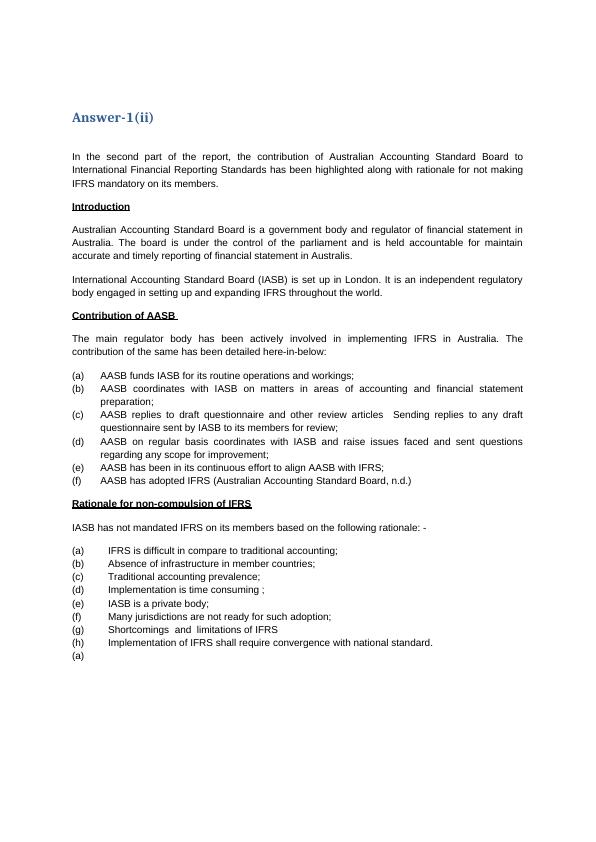Regulation of Financial Statements and Analysis of Australian Listed Entities
Added on 2023-06-05
12 Pages2959 Words398 Views
Executive Summary...............................................2
Introduction............................................................3
Answer-1(i)............................................................3
Answer-1(ii)...........................................................4
Answer-2 and 3.....................................................5
Conclusion...........................................................10
References:.........................................................11
Introduction............................................................3
Answer-1(i)............................................................3
Answer-1(ii)...........................................................4
Answer-2 and 3.....................................................5
Conclusion...........................................................10
References:.........................................................11

CORPORATE AND FINANCIAL ACCOUNTING
Executive Summary
The document contains a brief description regarding the importance of regulation of financial
statement and the need for standardisation of the same by various regulatory authorities like
international Accounting Standard Board, Australian Accounting Standard Board etc;
In the second part, the document highlights about International Accounting Standard board and
Australian Accounting Standard Board and how AASB contributes to IFRS. The document also
mentions why IFRS is not mandatory on member states;
In the third part of the document, an analysis of four Australian listed entities have been carried out
with focus on equity and debt portion of statement of financial position
Executive Summary
The document contains a brief description regarding the importance of regulation of financial
statement and the need for standardisation of the same by various regulatory authorities like
international Accounting Standard Board, Australian Accounting Standard Board etc;
In the second part, the document highlights about International Accounting Standard board and
Australian Accounting Standard Board and how AASB contributes to IFRS. The document also
mentions why IFRS is not mandatory on member states;
In the third part of the document, an analysis of four Australian listed entities have been carried out
with focus on equity and debt portion of statement of financial position

Introduction
The report is an analysis of the following major parts which includes the need for regulation of
financial statement and about AASB and IASB and contribution of AASB to IFRS and also the
analysis of equity and debt position of four Australian listed companies.
Answer-1(i)
In the first part, the documents deals with the importance of regulation of financial statement and why
the same shall not be left at the disposal of the management to disclose documents voluntarily. The
rationale behind the same has been detailed here-in-below:
(a) Standardisation
A standardised financial statement is easy to understand and comprehend for its user. It leaves
less scope for omission of content and proper presentation of facts and information.
(b) Comparability
A regulated Financial Statement shall be comparable with the other on account of similar
presentation by all the companies in the country. This is very useful for the end user who
wishes to compare different companies;
(c) Disclosure of complete and proper information
When financial statement are properly documented and regulated appropriate information shall
be available to user in a timely manner. Thus, the same shall be useful to end user of financial
statement. If the same is unregulated, it shall give space for cooking of books by the
management and shall provide incomplete information to the end user;
(d) Global Scams
History has witnessed that wherever regulation has failed or there is shortcoming in the same,
the world has witnessed big scams like Enron etc. There is always a need for regulation.
(e) Biased nature of management
When management is given an opportunity to report voluntarily, only those elements shall be
reported in the financial statement which are in favour of company and their own benefit.
History has affirmed the same.
The report is an analysis of the following major parts which includes the need for regulation of
financial statement and about AASB and IASB and contribution of AASB to IFRS and also the
analysis of equity and debt position of four Australian listed companies.
Answer-1(i)
In the first part, the documents deals with the importance of regulation of financial statement and why
the same shall not be left at the disposal of the management to disclose documents voluntarily. The
rationale behind the same has been detailed here-in-below:
(a) Standardisation
A standardised financial statement is easy to understand and comprehend for its user. It leaves
less scope for omission of content and proper presentation of facts and information.
(b) Comparability
A regulated Financial Statement shall be comparable with the other on account of similar
presentation by all the companies in the country. This is very useful for the end user who
wishes to compare different companies;
(c) Disclosure of complete and proper information
When financial statement are properly documented and regulated appropriate information shall
be available to user in a timely manner. Thus, the same shall be useful to end user of financial
statement. If the same is unregulated, it shall give space for cooking of books by the
management and shall provide incomplete information to the end user;
(d) Global Scams
History has witnessed that wherever regulation has failed or there is shortcoming in the same,
the world has witnessed big scams like Enron etc. There is always a need for regulation.
(e) Biased nature of management
When management is given an opportunity to report voluntarily, only those elements shall be
reported in the financial statement which are in favour of company and their own benefit.
History has affirmed the same.

Answer-1(ii)
In the second part of the report, the contribution of Australian Accounting Standard Board to
International Financial Reporting Standards has been highlighted along with rationale for not making
IFRS mandatory on its members.
Introduction
Australian Accounting Standard Board is a government body and regulator of financial statement in
Australia. The board is under the control of the parliament and is held accountable for maintain
accurate and timely reporting of financial statement in Australis.
International Accounting Standard Board (IASB) is set up in London. It is an independent regulatory
body engaged in setting up and expanding IFRS throughout the world.
Contribution of AASB
The main regulator body has been actively involved in implementing IFRS in Australia. The
contribution of the same has been detailed here-in-below:
(a) AASB funds IASB for its routine operations and workings;
(b) AASB coordinates with IASB on matters in areas of accounting and financial statement
preparation;
(c) AASB replies to draft questionnaire and other review articles Sending replies to any draft
questionnaire sent by IASB to its members for review;
(d) AASB on regular basis coordinates with IASB and raise issues faced and sent questions
regarding any scope for improvement;
(e) AASB has been in its continuous effort to align AASB with IFRS;
(f) AASB has adopted IFRS (Australian Accounting Standard Board, n.d.)
Rationale for non-compulsion of IFRS
IASB has not mandated IFRS on its members based on the following rationale: -
(a) IFRS is difficult in compare to traditional accounting;
(b) Absence of infrastructure in member countries;
(c) Traditional accounting prevalence;
(d) Implementation is time consuming ;
(e) IASB is a private body;
(f) Many jurisdictions are not ready for such adoption;
(g) Shortcomings and limitations of IFRS
(h) Implementation of IFRS shall require convergence with national standard.
(a)
In the second part of the report, the contribution of Australian Accounting Standard Board to
International Financial Reporting Standards has been highlighted along with rationale for not making
IFRS mandatory on its members.
Introduction
Australian Accounting Standard Board is a government body and regulator of financial statement in
Australia. The board is under the control of the parliament and is held accountable for maintain
accurate and timely reporting of financial statement in Australis.
International Accounting Standard Board (IASB) is set up in London. It is an independent regulatory
body engaged in setting up and expanding IFRS throughout the world.
Contribution of AASB
The main regulator body has been actively involved in implementing IFRS in Australia. The
contribution of the same has been detailed here-in-below:
(a) AASB funds IASB for its routine operations and workings;
(b) AASB coordinates with IASB on matters in areas of accounting and financial statement
preparation;
(c) AASB replies to draft questionnaire and other review articles Sending replies to any draft
questionnaire sent by IASB to its members for review;
(d) AASB on regular basis coordinates with IASB and raise issues faced and sent questions
regarding any scope for improvement;
(e) AASB has been in its continuous effort to align AASB with IFRS;
(f) AASB has adopted IFRS (Australian Accounting Standard Board, n.d.)
Rationale for non-compulsion of IFRS
IASB has not mandated IFRS on its members based on the following rationale: -
(a) IFRS is difficult in compare to traditional accounting;
(b) Absence of infrastructure in member countries;
(c) Traditional accounting prevalence;
(d) Implementation is time consuming ;
(e) IASB is a private body;
(f) Many jurisdictions are not ready for such adoption;
(g) Shortcomings and limitations of IFRS
(h) Implementation of IFRS shall require convergence with national standard.
(a)

End of preview
Want to access all the pages? Upload your documents or become a member.
Related Documents
Corporate and Financial Accounting: Analysis of Regulation and Equity Segment of Listed Entities in Australian Exchangelg...
|11
|3133
|94
Corporate and Financial Accounting: Financial Reporting Regulation and Analysis of ASX Listed Retail Companieslg...
|20
|3154
|343
Corporate and Financial Accountinglg...
|15
|3060
|329
HA2032 Corporate and Financial Accounting Assignmentlg...
|15
|3338
|107
Corporate Accounting: Financial Reporting Regulation, AASB Participation in Setting Global Standards, and Equity Analysislg...
|15
|3465
|114
Corporate Financial Accounting: Regulation, Standards, and Equity Analysislg...
|15
|3528
|340
